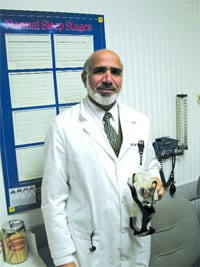Getting the Message Across The Art and Science of How Hospitals Communicate with the Public
Suzanne Hendery says there is a “mysterious process” that most people don’t understand that leads doctors to admit patients to specific hospitals. She learned about it years ago when her grandmother was sent to a hospital Hendery never would have chosen for her.
“I didn’t understand that her doctor was on their staff and his credentials only allowed him to admit patients there,” said Baystate Health’s vice president of marketing and communications, adding that she switched her grandmother’s physician after that experience.
In fact, a 2008 study shows that 46{06cf2b9696b159f874511d23dbc893eb1ac83014175ed30550cfff22781411e5} of people believe they will decide where they will be hospitalized if and when it becomes necessary. “But your doctor and insurance company have a huge influence on where you are admitted,” Hendery said.
Educating people about their health, providing them with this type of information, and letting them know what different medical centers offer is one reason why hospital marketing and communication departments exist. Their missions vary, but they share the goal of raising consumer awareness about what they do best.
“Ads are a very small fraction of what we do,” said Hendery. “It’s very different than traditional marketing.”
Meanwhile, the Sisters of Providence Health System (SPHS) uses a special lens to view its marketing efforts, which are focused on its mission to be a transforming and healing presence in the community.
“We have been doing that for almost 150 years and believe in being servant leaders,” said Mark Fulco, senior vice president of strategy and marketing. “For us, health care is not a business, it is a ministry. To be able to serve people in their time of need is both an incredible privilege and an incredible responsibility. And since it is our highest calling, our job is not to sell a product or promote it. It is to tell the story of Mercy so people know what we do, how we do it, and why. We think it’s important that people know that Mercy has almost everything you would find at a major academic center in Boston, but is close to their home.”
This month, the Healthcare News takes an inside look at the messages hospital marketing departments in Western Mass. are trying to convey and the methods they are using to accomplish this mission.
Communication Counts
One of Baystate Health’s primary goals is to ask people what they want, listen to them, then deliver it, said Hendery. “It’s that easy — and that complicated,” she explained. “But we love it. We feel we are personally enhancing patient care each day.”
There are many stories to tell, since Baystate employs 450 practitioners and another 2,000 have the credentials to admit patients to their hospitals. “But some health care plans won’t let patients receive care at their hospital of choice. So it’s key for people to understand that and check with their employer to see what hospitals are covered under their plan,” she said. “We understand from a patient’s perspective how complex health care can be. So we try to develop messages to allow them to make better decisions.”
All of the system’s marketing materials are tested to make sure they are clear and resonate with consumers and physicians about what makes Baystate unique, she continued.
“One of the reasons we are special is that we are affiliated with Tufts University School of Medicine. So we are not only training doctors of the future, our doctors are scholars or researchers who conduct clinical trials to test new pharmaceuticals, processes, and procedures, then they publish them for the advancement of medicine,” Hendery said. In addition, their physicians also conduct research in the laboratories at Pioneer Life Valley Sciences Institute in Springfield.
Baystate is rated in the top 3{06cf2b9696b159f874511d23dbc893eb1ac83014175ed30550cfff22781411e5} of hospitals for nursing excellence. But putting this and other, numerous awards aside, Hendery said the system understands that a person’s relationship with their physician will affect which hospital they choose. “So, our brand is all about our doctors. We encourage people to make an introductory 10-minute appointment or go to a seminar and listen to the physician who is giving it,” she said, adding that research shows 30{06cf2b9696b159f874511d23dbc893eb1ac83014175ed30550cfff22781411e5} of people who meet with a doctor and have a good connection make an appointment within the next month.
To that end, the system runs free educational programs almost every night via its Spirit of Women and Senior Class programs that allow people to interact with doctors.
Another way it reaches out to the community is via the so-called Mini-Medical School staged twice a year for 100 people who pay $95 to attend an eight-week program.
“We always have a waiting list,” Hendery said. “We do these things because we want to create excellent relationships between consumers and our doctors.”
Baystate monitors its physicians’ practices by shadowing them and putting people in their waiting rooms to see what the experience is like. “The doctors are very interested in our results and know their scores,” Hendery said, noting that phone surveys also provide valuable feedback.
Focus groups are another means of determining what consumers want. “We also have a patient and family advisory council at each of our hospitals which gives us feedback,” Hendery said.
These measures have earned Baystate’s D’Amour Center for Cancer Care the number-one rating in the country in terms of patient satisfaction. This is important, Hendery said, because the patient’s experience is key to the facility’s success. “Our aim is to make every person feel that they have been treated with dignity and respect and as a partner in their health care. Only then will we have a loyal patient who will always say, ’Baystate is my choice.’”
Fulfilling a Mission
Fulco says the SPHS tagline — “a much better health care experience” — has more meaning than the words express.
“It is a core cultural philosophy across our entire system, which falls under the umbrella of Mercy Medical Center, and includes Weldon Rehabilitation Center, Providence Behavioral Health Hospital, Mercy’s Continuing Care Network, and Life Laboratories,” he explained, adding that Brightside for Families and Children in West Springfield still exists although its focus has changed from a residential facility to one that provides outpatient and family-stabilization services.
The SPHS Balance magazine, which is mailed to 75,000 households and put in waiting rooms in their facilities, is one of the publications Fulco’s department produces.
“Our front cover says, ’Health and Wellness News for Western Massachusetts,’ and this is a clear example of what we do,” Fulco said, adding that the magazine exists to educate people about health issues.
The marketing department is small and works within a very tight budget. “Most hospitals use an advertising agency, but we are very frugal,” said Fulco. “We have our own print shop, and we design and produce our own business cards, letterheads, and stationery, which goes back to our mission, as we think SPHS’s money should be focused on patient care,” Fulco explained.
The core of the system’s outreach is accomplished through wellness programs and classes, Balance magazine, monthly ads in newspapers, brochures, and an online presence which includes listings for Healthy Balance seminars conducted by its physicans.
Mercy officials are proud they have been ranked among the top 100 hospitals by the health care consulting firm Cleverley + Associates. “But our ads about this are not just bragging. We are a value-based provider, and we take health care one step further,” Fulco said, adding that consumers can use the system’s Web site to find scores the government gives the hospital.
The department produces a physician directory and internal publications for staff and donors, and also helps with program development, Fulco said, showing off a brochure about trigeminal neuralgia that is mailed to physicians to help them identify the condition and let them know that Mercy has one of the few surgeons in the state who treats the problem.
“It was so effective that US Air contacted us and did an article about it; we received referrals from as far away as Florida and Kansas City, Mo.,” Fulco said, adding that the system does its best to enhance the hospital experience by providing services such as free wi-fi service in waiting areas and some hospital rooms. “It is a driving consideration for us to make things convenient for patients and their families.”
Community Matters
At Noble Hospital in Westfield, the marketing department is focused on two things: letting consumers know they have a choice and getting to know the people in their community on a personal level.
“We actually go out into the community and meet with people so we get to know our patients and their family members,” said Allison Gearing-Kalill, who is Noble’s vice president of community development.
About a year ago, the hospital launched an initiative called Noble Conversations, which invites people in the community to stage a get-together in their home for 10 or 20 friends. The guest speakers are Noble Hospital CEO Robert Perry, Noble’s director of nursing, and one of their physicians, who will talk about what the hospital has to offer, answer questions, and listen to people’s concerns.
The parties have become very popular, and the program has “snowballed,” Gearing-Kalill said. “It makes it easy for people to ask questions. They enjoy it, and it becomes very personal. Whether they have an issue or a wonderful experience, we take notes and make sure our staff knows what took place. If an issue is presented, we try to make improvements, and if it is something wonderful, we share that, too.”
The program has brought Noble much closer to the community.
“We also go into nursing homes and retirement communities in addition to participating in community wellness fairs or staging our own, said Gearing-Kalill. “But I don’t know of any other hospital CEO who will go to people’s homes for two and a half or three hours.”
Other tools used to heighten awareness include their quarterly magazine, which is mailed to every household in Westfield, Blandford, Russell, and Southwick. The hospital also uses Facebook to get the word out about new accreditations and events such as the annual Noble Ball and 5K road race. Twitter and newspaper ads also play a role in its strategy.
“Without our Community Development office, people wouldn’t know about or understand all of the services we have. People think all hospitals are the same, but we have our niche,” said Gearing-Kalill. “We are committed to our community and participate in the Chamber of Commerce as well as doing our part to help non-profits. Plus, we take part in special events in Westfield. It’s important to keep our name out there and keep people aware of the services we have.”
This includes their emergency room and location, which are critical to residents in towns far away from larger medical facilities. “A lot of lives have been saved by people coming here. If the situation is beyond our capabilities, we can transfer the person,” Gearing-Kalill said.
These marketing departments play a important role in the decisions people make about where they receive their health care. It is an important one that can affect their health and create a lasting impression for them as well as for their family members, friends, and neighbors.




Comments are closed.